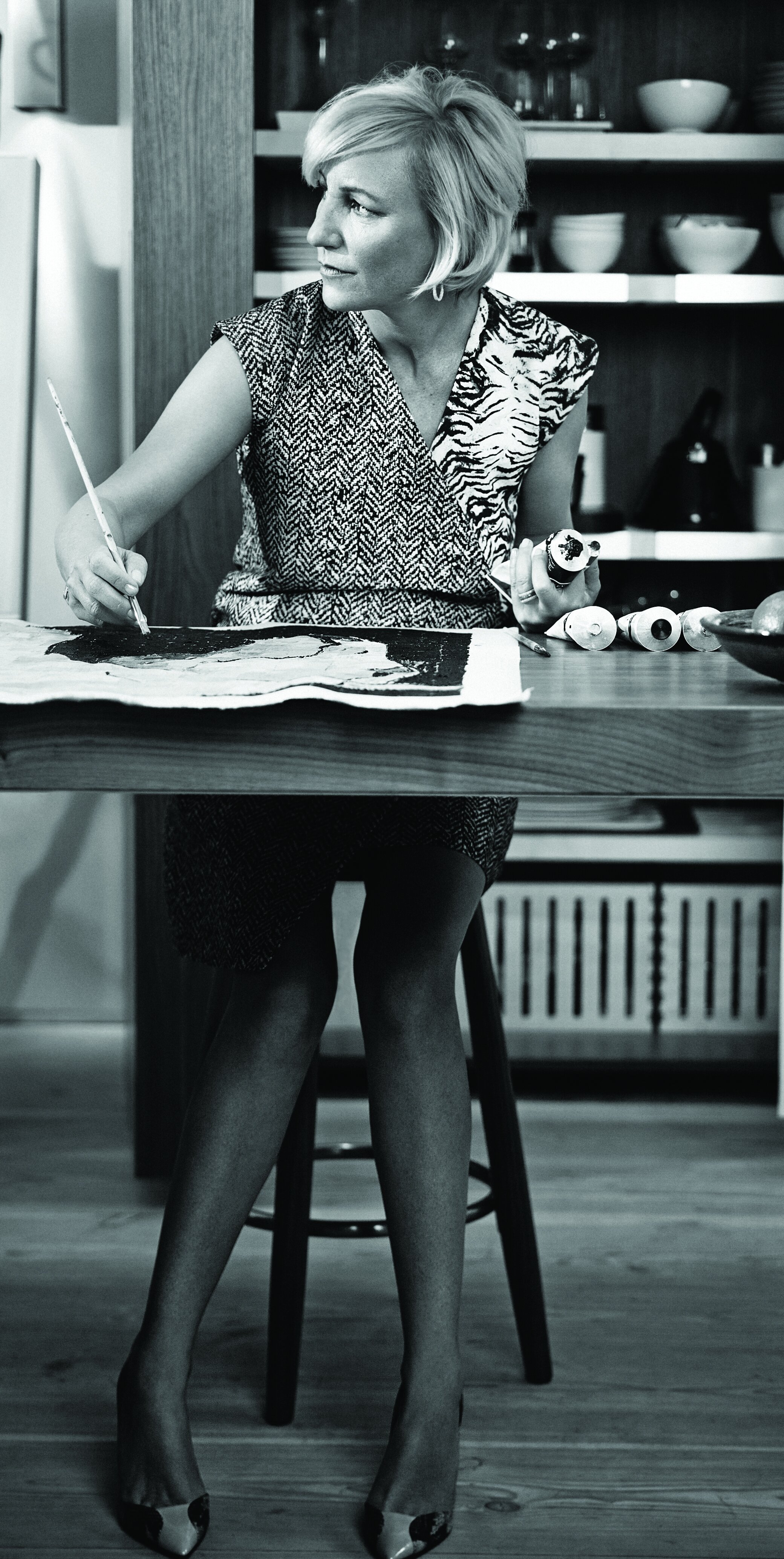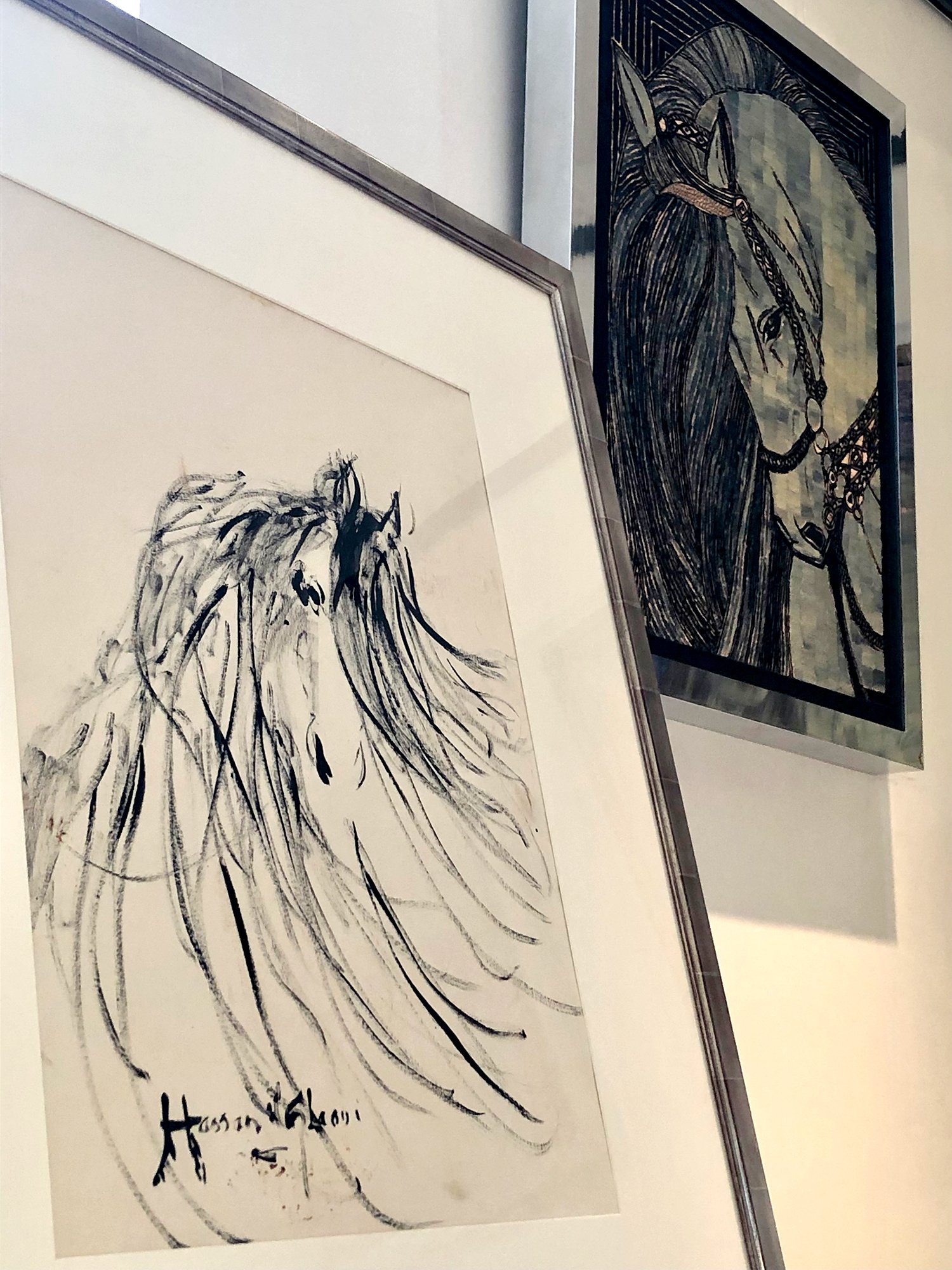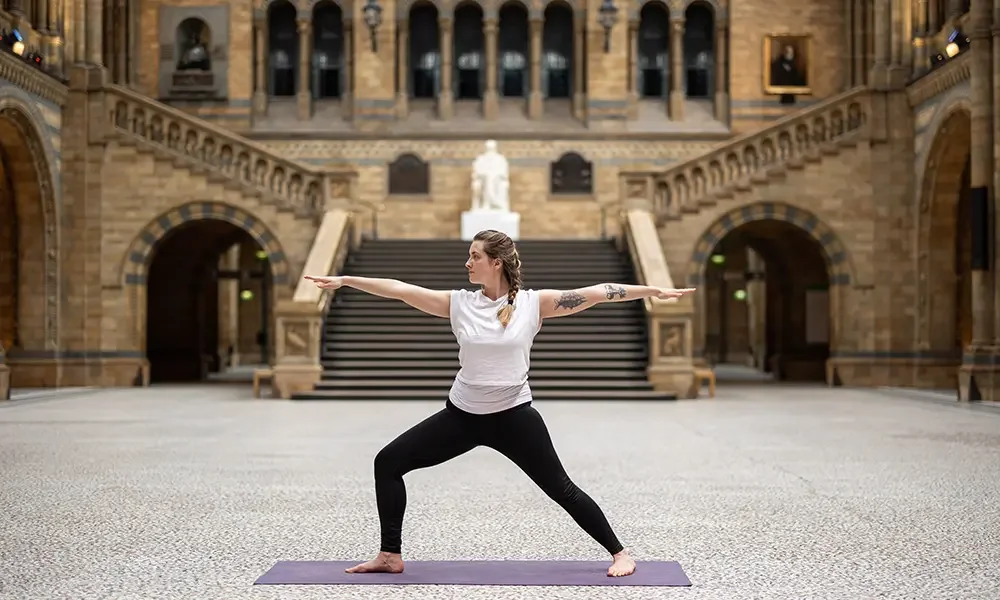In conversation with Ghizlan El Glaoui
“I want my portraits to feel timeless and to lay bare an intuition and integrity, a kind of wisdom and solemnity.”
- Ghizlan El Glaoui
Image: Ghizlan El Glaoui. © Glebe Garden Gallery
Ghizlan El Glaoui is a Moroccan-born artist based in London. Known for her richly hued, expressive painted portraits, her use of light and texture bridges the ancient and modern, the classical and the contemporary. A uniquely multifaceted artist, Ghizlan creates work across painting, drawing, and – in a distinctively beautiful way – light. Born in Morocco in 1969, Ghizlan spent much of her childhood in the studio of her father, the world-renowned painter Hassan El Glaoui. Often the subject of his portraits, she was immersed in his world of colour, energy and inspiration, surrounded by the familiar heady smell of paint and linseed oil. Going on to study at L'Académie Charpentier in Paris, Ghizlan developed a style inspired by her father in the use of light and colour, as well as Modigliani, Botticelli, Klimt and Da Vinci, whose vestiges can all be seen acutely in her use of line and texture.
Ghizlan’s stunning painted portraits of Berber women, geishas, Hollywood icons and animals are highly contemporary while hinting towards her special heritage. Raised in two worlds, her works are distinctive in both style and substance, blending the Marrakesh of her childhood with the modernity of London. Working on painted canvas in tandem with the latest LED lighting technology Ghizlan’s paintings have a mosaic-esque quality, each mark placed with careful consideration yet in constant play with the light as it glints through a grid like pattern.
When did you know you wanted to be an artist?
I think in many ways I always knew that art and creativity was in my blood. I was born in Morocco and spent much of my childhood in the studio of my late father, Hassan El Glaoui, who was and still is a renowned painter. I used to sit for him for hours and I was immersed completely in his world of colour and energy, surrounded by the heady smell of paint and linseed oil. My mother was a model for Givenchy and also encouraged my creativity through many outlets…so when I was not in my father’s studio, I was often either riding or practising dance or music. If not an artist, I might have pursued one of those routes, however it was when I went to study at L'Académie Charpentier in Paris that I began to see things take shape and I developed a style inspired by my father in the use of light and colour, as well line and texture.
How would you describe your artistic style? Would you say there is some sort of recognisable characteristic?
I would describe my works as expressive and dynamic, using traditional techniques of oil painting and tempera combined with a modern use of LED light. In my works, I am trying to use light and texture to bridge the ancient and modern, the classical and the contemporary. I suppose the recognisable characteristic of the work, apart from the use of LEDs, is the way in which I paint in grids, which I think gives the paintings a mosaic-esque quality. Each mark is placed very precisely, but they are all in constant play with the light as it glints through the painted pattern.
What messages and themes do you try to communicate in your work?
The subjects of my work include painted portraits of Berber women, geishas, Hollywood icons and animals such as tigers and lions, and most recently horses. In all of these, I am trying to use a particular style and technique to hint towards my special heritage, but in a contemporary way. But, more than that, I am interested in using artistic expression to tie together the physical and the metaphysical, the outer and inner self. I want my portraits to feel timeless and to lay bare an intuition and integrity, a kind of wisdom and solemnity. The physical body is a bridge to a more powerful force – the inner strength, light and aura that are the true self.
Do any past or current artists inspire you?
Many! Including my father of course…. other artists that have sparked something in my own work include Modigliani, Botticelli, Klimt and Da Vinci. There are so many talented artists working right now…In the future I look forward to collaborating with some in my atelier and in other places.
Can you tell us how your latest collection came about?
The new ‘Berber’ collection has been in the making for a long time, but I was always a little hesitant as it naturally draws a comparison with my father by having the same subject – horses. His horses and riders are known and collected worldwide. My new ‘Berber’ artworks are completely different, event though in a way they were created in homage to my father, his works and his legacy. ‘Berber’ is a collection of portraits of horses and women, and the series is obviously deeply connected with the Marrakesh of my childhood. As I usually do with my portraits, I wanted to get close to the essence within – whether that is a woman or a horse... both are beautiful, strong, vulnerable and complex. I hope the people who visit can see a dialog.
Image: © Glebe Garden Gallery
How do you create your artwork?
I tend to focus on one subject for a long time, getting to know it intimately, to a point where I really know the details of a face or a form, and I can paint it from memory. For example, with my latest Frida portraits, I can now experiment and really push the technique, the colour and texture, and have a bit of fun…because her image has become so familiar, I don’t focus on worrying about that element. In terms of my process, I might sketch some ideas on paper, but mostly I set to work straight on the canvas, drawing out a grid pattern if I intend to work in a mosaic-like way, and then using pencil to get the overall composition in place. I don’t ever stretch my canvases, I just lay them out and work direct, either on a table or on an easel. I use oil paints and tempera in my work, and sometimes metallic acrylics.
I have been working with LED lights for so long now, I tend to know what a work will look like when backlit long before they are framed on top of the panel...but that is always an exciting moment to see the lights dancing between the paint marks!
What is the best advice you have ever received?
My dear artist Father said to me: “Try abstract art, it is easier and more fashionable today.” I should follow his amazing advice more often.
Can you tell us about Glebe Garden Gallery?
Glebe Garden Gallery is situated in a historic part of Chelsea, one which has been a magnet for London’s artistic community since the 19th Century…a real creative and bohemian colony. One of the most famous artists to set up a studio here was JMW Turner, who lived his final years nearby on Cheyne Walk. His art studio, however, was on Glebe Place. You can see his blue plaque just a minute’s walk from here. Many artists from the Pre-Raphaelite Brotherhood have studios in the area, as well as Masters such as Walter Sickert, William Rothenstein and Whistler, who became one of the founding members of the Chelsea Arts Club. Glebe Garden Gallery itself was built in the 1880s and it began just as some glazed sheds designed by the sculptor and potter Conrad Dressler, who built it to be a series of artist studios, called Cedar Studios.
Image: © Glebe Garden Gallery
What do you hope visitors to Glebe Garden Gallery take away from the experience?
It means a lot to me to have kept the building as a studio, as was its original purpose…however I always wanted it to serve a dual purpose, so that as well as being a working studio it could be an atelier or salon where I could also show the work of other artists. When I first acquired the space, I worked hard to renovate it so that this could happen. I want it to be a place that feels homely as well as inspiring – I want people to see works in an environment that isn’t just a white box and see how art can really be lived with. With my ‘Berber’ works on show alongside some paintings of my father’s, I hope they can recognise a thread, and a nod to history and legacy, in much the same way that we show respect to the artists who came before and made Chelsea such a creative hub.
Can you tell us about any upcoming projects?
I am working towards several very exciting things, but the first project for 2023 will be an exhibition of works to be held at 12 Hay Hill, in collaboration with Nicholls Projects. The exhibition will open on Friday 24 February 2023.
Also, it is such an honour that I have been selected as Artist in Residence for the Prince Albert Foundation in Monaco. This will be for three months, starting from International Women’s Day, 8 March 2023 – we will also have a big closing event in June to celebrate. I am absolutely thrilled and can’t wait to see what may follow.
Website: ghizlanelglaoui.com
Instagram: @ghizlanelglaoui









